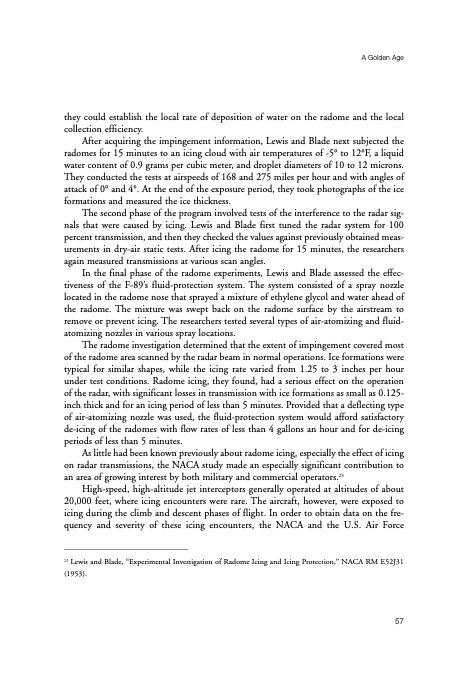
PDF Publication Title:
Text from PDF Page: 070
they could establish the local rate of deposition of water on the radome and the local collection efficiency. After acquiring the impingement information, Lewis and Blade next subjected the radomes for 15 minutes to an icing cloud with air temperatures of -5° to 12°F, a liquid water content of 0.9 grams per cubic meter, and droplet diameters of 10 to 12 microns. They conducted the tests at airspeeds of 168 and 275 miles per hour and with angles of attack of 0° and 4°. At the end of the exposure period, they took photographs of the ice formations and measured the ice thickness. The second phase of the program involved tests of the interference to the radar sig- nals that were caused by icing. Lewis and Blade first tuned the radar system for 100 percent transmission, and then they checked the values against previously obtained meas- urements in dry-air static tests. After icing the radome for 15 minutes, the researchers again measured transmissions at various scan angles. In the final phase of the radome experiments, Lewis and Blade assessed the effec- tiveness of the F-89’s fluid-protection system. The system consisted of a spray nozzle located in the radome nose that sprayed a mixture of ethylene glycol and water ahead of the radome. The mixture was swept back on the radome surface by the airstream to remove or prevent icing. The researchers tested several types of air-atomizing and fluid- atomizing nozzles in various spray locations. The radome investigation determined that the extent of impingement covered most of the radome area scanned by the radar beam in normal operations. Ice formations were typical for similar shapes, while the icing rate varied from 1.25 to 3 inches per hour under test conditions. Radome icing, they found, had a serious effect on the operation of the radar, with significant losses in transmission with ice formations as small as 0.125- inch thick and for an icing period of less than 5 minutes. Provided that a deflecting type of air-atomizing nozzle was used, the fluid-protection system would afford satisfactory de-icing of the radomes with flow rates of less than 4 gallons an hour and for de-icing periods of less than 5 minutes. As little had been known previously about radome icing, especially the effect of icing on radar transmissions, the NACA study made an especially significant contribution to an area of growing interest by both military and commercial operators.23 High-speed, high-altitude jet interceptors generally operated at altitudes of about 20,000 feet, where icing encounters were rare. The aircraft, however, were exposed to icing during the climb and descent phases of flight. In order to obtain data on the fre- quency and severity of these icing encounters, the NACA and the U.S. Air Force A Golden Age 23 Lewis and Blade, “Experimental Investigation of Radome Icing and Icing Protection,” NACA RM E52J31 (1953). 57PDF Image | History of NASA Icing Research Tunnel

PDF Search Title:
History of NASA Icing Research TunnelOriginal File Name Searched:
sp4226.pdfDIY PDF Search: Google It | Yahoo | Bing
NFT (Non Fungible Token): Buy our tech, design, development or system NFT and become part of our tech NFT network... More Info
IT XR Project Redstone NFT Available for Sale: NFT for high tech turbine design with one part 3D printed counter-rotating energy turbine. Be part of the future with this NFT. Can be bought and sold but only one design NFT exists. Royalties go to the developer (Infinity) to keep enhancing design and applications... More Info
Infinity Turbine IT XR Project Redstone Design: NFT for sale... NFT for high tech turbine design with one part 3D printed counter-rotating energy turbine. Includes all rights to this turbine design, including license for Fluid Handling Block I and II for the turbine assembly and housing. The NFT includes the blueprints (cad/cam), revenue streams, and all future development of the IT XR Project Redstone... More Info
Infinity Turbine ROT Radial Outflow Turbine 24 Design and Worldwide Rights: NFT for sale... NFT for the ROT 24 energy turbine. Be part of the future with this NFT. This design can be bought and sold but only one design NFT exists. You may manufacture the unit, or get the revenues from its sale from Infinity Turbine. Royalties go to the developer (Infinity) to keep enhancing design and applications... More Info
Infinity Supercritical CO2 10 Liter Extractor Design and Worldwide Rights: The Infinity Supercritical 10L CO2 extractor is for botanical oil extraction, which is rich in terpenes and can produce shelf ready full spectrum oil. With over 5 years of development, this industry leader mature extractor machine has been sold since 2015 and is part of many profitable businesses. The process can also be used for electrowinning, e-waste recycling, and lithium battery recycling, gold mining electronic wastes, precious metals. CO2 can also be used in a reverse fuel cell with nafion to make a gas-to-liquids fuel, such as methanol, ethanol and butanol or ethylene. Supercritical CO2 has also been used for treating nafion to make it more effective catalyst. This NFT is for the purchase of worldwide rights which includes the design. More Info
NFT (Non Fungible Token): Buy our tech, design, development or system NFT and become part of our tech NFT network... More Info
Infinity Turbine Products: Special for this month, any plans are $10,000 for complete Cad/Cam blueprints. License is for one build. Try before you buy a production license. May pay by Bitcoin or other Crypto. Products Page... More Info
| CONTACT TEL: 608-238-6001 Email: greg@infinityturbine.com | RSS | AMP |